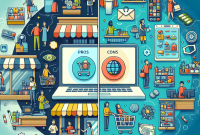
The Rise of Online Shopping: How E-commerce is Changing the Retail Landscape
Welcome to an exploration of how e-commerce has revolutionized the retail industry. In this article, we will delve into the transformative impact of online shopping on traditional brick-and-mortar stores, consumer behavior, and the overall retail landscape. Let’s take a closer look at this evolving trend.
The Growth of E-commerce
In recent years, e-commerce has experienced exponential growth, fueled by advancements in technology, changing consumer preferences, and the convenience of online shopping. According to Statista, global e-commerce sales amounted to over $4.2 trillion in 2020, and this number is projected to reach $6.4 trillion by 2024. This staggering growth has reshaped the retail sector in profound ways.
Benefits of Online Shopping
Online shopping offers a myriad of benefits to consumers, including convenience, a wider selection of products, competitive pricing, and the ability to shop from anywhere at any time. With just a few clicks, customers can compare prices, read reviews, and make purchases without leaving the comfort of their homes. This convenience has led to a significant shift in consumer behavior.
Challenges for Traditional Retailers
As e-commerce continues to gain traction, traditional brick-and-mortar retailers are facing increasing competition and pressure to adapt to changing consumer preferences. Many legacy retailers have had to rethink their business models, invest in online platforms, and enhance their digital capabilities to stay relevant in the digital age.
The Impact on Consumer Behavior
The rise of online shopping has fundamentally altered consumer behavior, shaping how people browse, shop, and interact with brands. With the convenience of online shopping, consumers now expect a seamless shopping experience, personalized recommendations, and fast delivery. E-commerce has empowered consumers to make informed purchasing decisions and discover new products with ease.
Changing Retail Landscape
The evolving retail landscape is characterized by a blend of online and offline shopping experiences. Many retailers have adopted an omnichannel approach, combining physical stores with e-commerce platforms to reach a wider audience and provide a seamless shopping experience across different channels. This shift has blurred the lines between online and offline retail, creating new opportunities for retailers to engage with customers.
FAQs
How has e-commerce impacted traditional retail stores?
E-commerce has put pressure on traditional retail stores to adapt to changing consumer preferences and compete with online retailers. Many brick-and-mortar stores have had to enhance their digital presence, offer omnichannel shopping experiences, and rethink their store layouts to stay competitive.
What are some of the key benefits of online shopping for consumers?
Some key benefits of online shopping for consumers include convenience, a wider selection of products, competitive pricing, personalized recommendations, and the ability to shop from anywhere at any time. Online shopping has made it easier for consumers to compare prices, read reviews, and make purchases with just a few clicks.
Conclusion
In conclusion, the rise of online shopping has transformed the retail landscape, presenting both opportunities and challenges for retailers. As e-commerce continues to grow, it is essential for retailers to embrace digital innovation, enhance their online capabilities, and provide a seamless shopping experience to meet the evolving needs of consumers. By understanding the impact of e-commerce on the retail industry, retailers can position themselves for success in the digital era.






